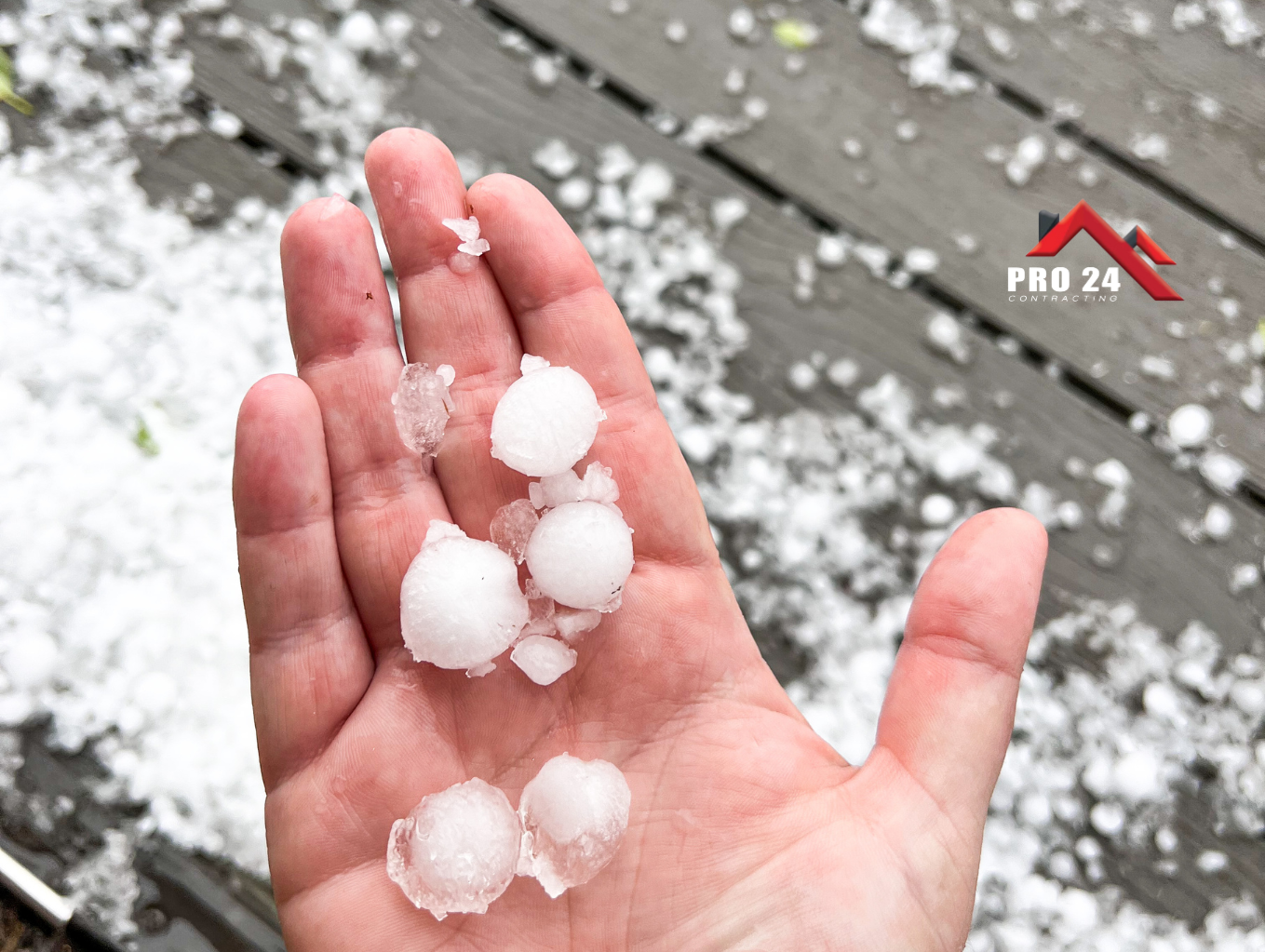Hailstorms can be sudden and fierce, leaving behind a trail of destruction that affects vehicles, landscaping, and most importantly, roofs. Your roof serves as the primary barrier protecting your home or business from the elements, and hail can compromise this protective layer in significant ways. Understanding the nature of hail damage, its effects on various roofing materials, and the importance of prompt inspections can help safeguard your property and extend the lifespan of your roof.
The Immediate Impacts of Hail on Roofing Materials
Hailstones come in various sizes, ranging from pea-sized pellets to golf-ball-sized chunks. The damage they cause depends on their size, density, and speed, as well as the type and condition of your roof. Let’s explore how hail can impact different roofing materials:
1. Asphalt Shingles
Asphalt shingles are one of the most common roofing materials, but they are particularly vulnerable to hail damage. Hailstones can cause:
- Granule Loss. The top layer of asphalt shingles is covered with granules that protect the material from UV rays. Hailstones can knock these granules off, exposing the underlying asphalt to the sun, which accelerates aging and degradation.
- Cracks and Bruises. Large or dense hailstones can crack shingles or create soft spots (bruises) that compromise their structural integrity.
- Loosened Adhesive. Repeated impacts can loosen the adhesive that secures shingles to the roof, increasing the risk of wind damage.
2. Metal Roofs
Metal roofs are known for their durability, but they are not entirely hail-proof. Common issues include:
- Dents. Hailstones can leave noticeable dents, especially on thinner or softer metals like aluminum.
- Coating Damage. The protective coating on metal roofs can chip away upon impact, exposing the metal to rust and corrosion over time.
3. Tile Roofs
Clay and concrete tiles are robust and long-lasting, but they can crack or shatter under the force of large hailstones. Cracked tiles can allow water to seep through, potentially leading to leaks and water damage inside the building.
4. Wood Shakes and Shingles
Wood roofing materials are particularly susceptible to splintering and cracking during hailstorms. Splintered wood can weaken the roof’s structure and create openings for water infiltration.
5. Flat Roofs
Flat roofs, often covered with rubber, PVC, or other membranes, can suffer from:
- Punctures. Hailstones can pierce the membrane, especially if the hail is sharp-edged or the roof is aging.
- Pooling Water. Indentations caused by hail can lead to areas where water pools, increasing the risk of leaks.
Factors That Influence Hail Damage
While the type of roofing material plays a significant role, other factors also determine the extent of hail damage:
1. Hailstone Size and Density
Larger and denser hailstones have greater impact energy, increasing the likelihood of severe damage. For example, hailstones larger than 2 inches in diameter can crack even the most durable roofing materials.
2. Wind Speed and Direction
Strong winds can drive hailstones with greater force and at angles that make them more damaging. Roofs facing the direction of the storm are often hit hardest.
3. Roof Age and Condition
Older roofs are more susceptible to hail damage due to wear and tear. A roof that already has minor cracks or loose shingles is more likely to sustain significant damage during a hailstorm.
4. Roof Slope and Orientation
Steeper roofs may deflect some of the force of hailstones, while flatter surfaces can absorb more direct impacts. The orientation of your roof relative to the storm can also influence damage severity.
Hidden Issues Caused by Hailstorms
Not all hail damage is immediately visible. Some issues may develop over time, leading to costly repairs if not addressed promptly:
- Water Leaks. Small cracks or punctures can allow water to seep into the roofing structure, leading to leaks and water damage inside the building.
- Mold and Mildew. Moisture from leaks can create an environment conducive to mold and mildew growth, posing health risks to occupants.
- Structural Weakening. Repeated impacts from hail can weaken the roof’s structure, making it less capable of withstanding future storms.
The Importance of Timely Roof Inspections
After a hailstorm, it’s crucial to have your roof inspected by professionals. Here’s why:
1. Identify Hidden Damage
Many forms of hail damage, such as hairline cracks, granule loss, or minor bruises, are not immediately visible to the untrained eye. Professional inspectors have the tools and expertise to uncover these hidden issues before they escalate into major problems, such as water infiltration or structural weakening.
2. Prevent Long-Term Issues
Timely inspections can catch minor problems early, allowing for quick repairs that prevent further deterioration. For example, addressing a small puncture caused by hail can save you from dealing with extensive water damage or costly mold remediation down the line.
3. Ensure Roof Warranty Compliance
Some roofing warranties require periodic inspections to remain valid. A professional inspection after a hailstorm ensures that you meet these requirements, preserving your warranty coverage.
4. Document Damage for Insurance Claims
If you’re filing an insurance claim, having a detailed report from a professional inspection is essential. This documentation can provide the evidence needed to support your claim, streamlining the process and increasing your chances of receiving adequate compensation for repairs or replacements.
5. Enhance Property Value
A well-maintained and inspected roof not only protects your home but also adds to its value. If you plan to sell your property in the future, having records of timely inspections and repairs can reassure potential buyers and justify a higher asking price.
6. Peace of Mind
Having your roof thoroughly inspected and confirmed to be in excellent condition offers reassurance during future storms. It ensures your home or business is well-prepared and protected from the elements, giving you confidence and peace of mind.
Steps to Take After a Hailstorm
If your property has been hit by a hailstorm, follow these steps to minimize damage and protect your investment:
- Visually Inspect Your Roof. Carefully assess your roof from the ground using binoculars to spot any visible damage, such as missing shingles, cracks, or dents. Avoid climbing onto the roof, as it may have unseen structural weaknesses.
- Inspect Surrounding Areas. Check your gutters, downspouts, and exterior walls for dents or damage. Look for granules from shingles in your gutters, which could indicate granule loss.
- Examine Your Attic. Inspect your attic for signs of water leaks or daylight shining through. Early detection of leaks can prevent water damage from escalating.
- Protect Vulnerable Areas. If you identify significant damage, cover exposed areas with a tarp or waterproof sheeting to prevent further deterioration until professional repairs can be made.
- Schedule a Professional Inspection. Contact a trusted roofing contractor, such as Pro 24 Contracting, for a thorough evaluation. Professionals can identify hidden damage and provide a comprehensive report.
- Document the Damage. Take detailed photographs of all visible damage, both on the roof and around your property. This documentation is essential for insurance claims.
- File an Insurance Claim. Notify your insurance company promptly. Provide all necessary documentation, including photos and the professional inspection report, to expedite your claim process.
- Plan for Repairs. Work with your roofing contractor to schedule necessary repairs or replacements. Discuss material upgrades if needed to enhance your roof’s resilience against future storms.
Preventative Measures to Protect Your Roof
While you can’t control the weather, you can take steps to make your roof more resistant to hail damage:
- Choose Impact-Resistant Materials. Consider installing roofing materials rated for impact resistance, such as Class 4 asphalt shingles or metal roofing. These materials are designed to withstand significant impacts and can dramatically reduce the likelihood of damage during hailstorms.
- Maintain Your Roof Regularly. Routine maintenance is key to extending the life of your roof and its resilience to hail. Clean out gutters and downspouts to prevent water buildup, replace damaged or missing shingles promptly, and inspect flashing around vents and chimneys for signs of wear.
- Strengthen Vulnerable Areas. Identify and reinforce weaker parts of your roof, such as edges, valleys, and protrusions. Adding extra layers of protection, like impact-resistant underlayment or reinforced flashing, can bolster these vulnerable areas against hail damage.
- Install Protective Features. Hail guards and mesh covers can shield HVAC units, skylights, and solar panels from hail impacts. Additionally, upgrading your roof’s eaves and overhangs with stronger materials can help prevent damage to these areas.
- Trim Overhanging Branches. Trees near your roof can become hazardous during storms. Prune any branches extending over your roof to minimize the risk of them breaking and causing damage during high winds or hailstorms.
- Apply Protective Coatings. Some coatings are specifically designed to increase the durability of your roof. These coatings can add a layer of protection that helps absorb hail impacts and reduce the likelihood of cracking or puncturing.
Conclusion
Hail damage to your roof can range from minor cosmetic issues to severe structural problems that compromise the safety and integrity of your property. Understanding how hail impacts different roofing materials, recognizing the factors that influence damage, and taking immediate action after a storm can save you from costly repairs in the long run.
Investing in regular maintenance and inspections ensures your roof is equipped to withstand future hailstorms. Pro 24 Contracting offers comprehensive inspections, prompt repairs, and expert guidance to help protect your roof from the elements. Whether you’re preparing for future storms or recovering from recent hail damage, our team is ready to assist. Don’t wait until it’s too late—contact us today to secure the protection and longevity of your roof.

